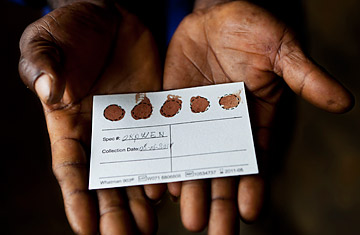
Hunters collect blood from animals they've killed and turn it in for research.
(6 of 6)
Wolfe sees it as a competition: Can our technological connectedness trump the risks of our biological and geographic connectedness? That's one reason he's pushed GVF to pioneer what he calls digital epidemiology, which uses the resources of the Internet to make predictive sense of the viral chatter picked up in the field. When he at last became a medical student, Gunasekara, now GVF's chief innovation officer, helped develop a system called Medic Mobile, which allows health workers in remote areas of developing countries to connect to hospitals. Now he and his team are setting up a bioinformatics strategy that could mine data from Internet searches and social media to pinpoint new outbreaks as they dawn--and potentially predict which newly discovered viruses might pose real threats to humanity. That work is culminating in a project called Epidemic IQ that will, Wolfe hopes, provide the ability to predict new pandemics the way the CIA might predict a terrorist attack.
GVF isn't the only place practicing digital epidemiology. At Harvard, bioinformatics expert John Brownstein has developed HealthMap, an app that scours the Web for information on emerging diseases and displays it geographically. Dr. Kamran Khan at the University of Toronto has helped create Bio.Diaspora, a project that integrates real-time information on infectious diseases with data on global travel patterns. But it's San Francisco--based GVF, with its Silicon Valley connections, that seems best poised to push the field forward. "Forecasting has been the missing piece of the puzzle," says Gunasekara. "We can mine data from the field and the Internet and try to come up with algorithms that forecast where these things are going next."
Wolfe's larger goal is to yank epidemiology into the digital age, to stop chasing pandemics as opposed to predicting and preventing them. "On infectious disease, we're where cardiology was in the 1950s," he says. "We're finally beginning to understand why pandemics happen instead of just reacting to them." What's needed is a global effort to scale up that kind of proactive work to ensure that every hot spot has surveillance running for new pathogens in animals and in human beings and that it has its own GVF-type group to do the work. Viruses don't respect borders--whether between nations or between species--and in a world where airlines act like bloodlines, global health is only as strong as its weakest link. We got lucky with the relatively weak swine-flu pandemic in 2009, but history tells us our luck won't last. "We sit here dodging bullets left and right, assuming we have an invisible shield," says Wolfe. "But you can't dodge bullets forever."
